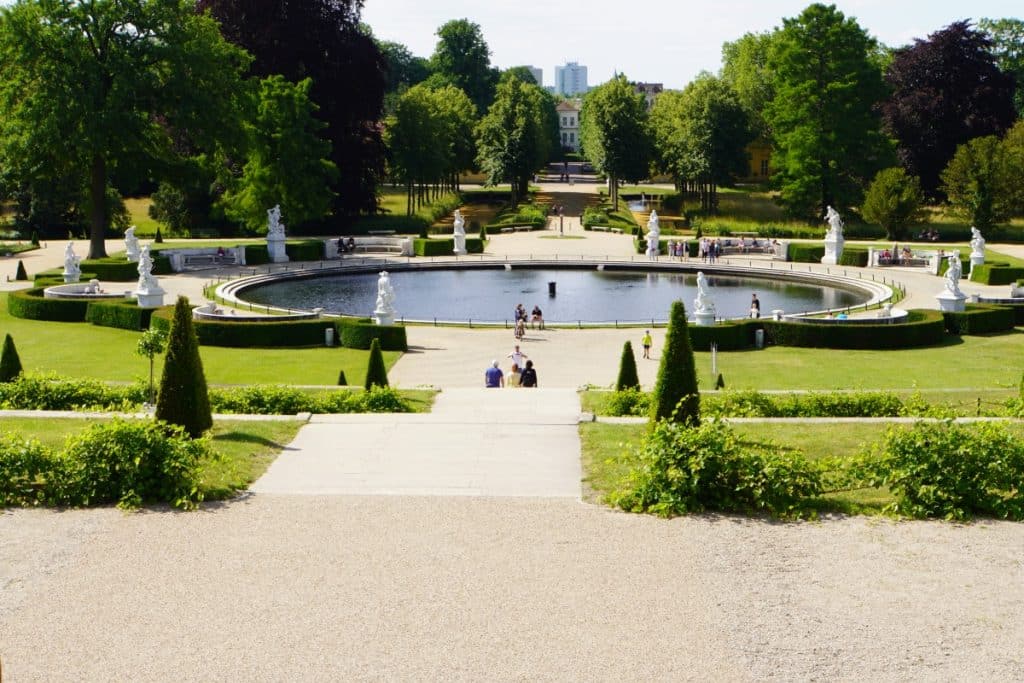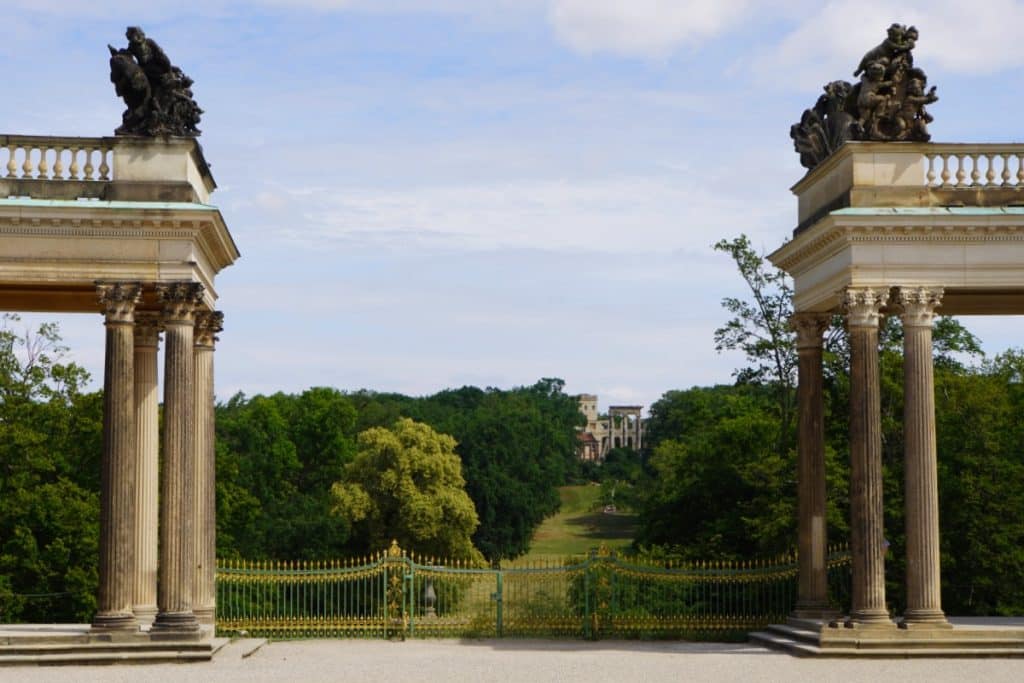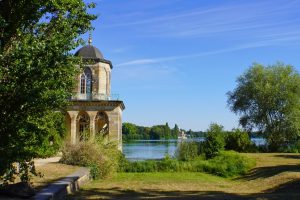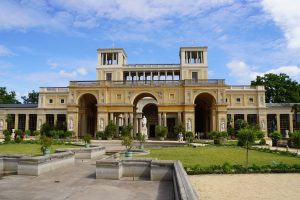A visit to Potsdam without strolling through Sanssouci Park is only half a visit. The palace park and palace are Potsdam’s most famous sights worldwide
As soon as I step through the entrance gate into the park, I feel like I’m in a fairy tale. Wide paths, past beautiful statues, lead to the castle. Actually, the only thing missing is the horse-drawn carriage that drives past me or the women in their historical dresses who walk past me.
You can visit the park free of charge and even without going into one of the many buildings, it is a day trip if you want to discover everything.

A park is being created
The Sanssouci Park (Sans=without, Souci=worry) was created according to the ideas of Frederick II after the construction of the palace was completed.
First the vineyard was terraced. This was followed by the design of the immediate surroundings. A baroque ornamental garden with lawns, flowers, hedges and trees in the style of French gardens dominated the picture. In addition, the gardeners laid out kitchen gardens with numerous fruit trees.

After more buildings were built in and around the park, the garden planners also extended the park. A dead-straight main avenue was created. It is almost 2 kilometres long and begins in the east at the Obelisk and ends in the west at the New Palace. When the Picture Gallery and the New Chambers were completed, rondels were added to the main avenue. Some of the architects installed fountains and statues on the new roundels. They laid out the new paths in a star shape, leading to the new buildings and landscaped garden areas.

Water features were an important element in Baroque gardens. Frederick the Great spent a lot of money to have fountains built in his gardens and parks. This was also the case in Sanssouci Park. Unfortunately, the master builder seemed to have little idea. He was unable to channel the water from the basin on Ruinenberg into the park. The planned water features did not work. It was only with the help of steam power that it was possible to operate the water features a good 100 years later. In 1842, the Great Fountain on the vineyard terraces went into operation and the water jet rose 38 metres high. To this day, this fountain is one of the main attractions in Sanssouci Park.

Frederick William III extended the already quite large park grounds in a southerly direction and donated the area to his son in 1825. After the construction of Charlottenhof Palace was completed, Peter Joseph Lenné began to design the gardens. In the partly marshy terrain, an open landscape park with large meadow areas was created. Only occasionally did Lenné plant groups of trees and shrubs. He took care to maintain a visual axis between Charlottenhof Palace, the Roman Baths and the New Palace with the Temple of Friendship.

Buildings in Sanssouci Park
During the 18th and 19th centuries, every Prussian ruler helped shape Sanssouci Park. Architects, sculptors, painters, decorators and garden designers created a park of about 290 hectares in size and a good 70 kilometres in length. In addition, numerous buildings were created that still characterise the park today:
- Picture gallery
- New chambers
- Neptune Grotto
- Chinese House
- New Palace with the Communs and the Triumphal Gate
- Temple of Friendship
- Temple of Antiquity
- Obelisk Portal and the Obelisk
- Artificial ruins on the Ruinenberg
- Belvedere on the Klausberg
- Royal vineyard on the Klausberg
- Dragon House
- Vineyard at the Triumphtor
- Charlottenhof Palace
- Roman Baths
- Friedenskirche with the adjacent groups of buildings
- Orangery Palace
Some of these beautiful buildings can also be seen from the inside, all buildings are wonderful to see on a walk from the outside.

Sanssouci Palace
During my walk through Sanssouci Park, I was also drawn to Sanssouci Palace, which was the summer residence of the Prussian kings and German emperors from 1747 to 1918. The area around the palace is wonderful to explore. Of course, it is also possible to visit the palace. However, you need an entrance ticket, which you should buy online in advance.

The stairs at the vineyard
The garden view of Sanssouci is certainly the most famous view of the palace. On the stairs leading up the vineyard from the park, almost every visitor takes a photo and actually there is always someone standing on the stairs. Sometimes you have to be lucky. If you visit the castle very early, shortly after the park opens, you may have the “bad luck” that the famous fountain is not yet gushing, but with a bit of luck you won’t have any other visitors on the stairs. I was lucky that there were hardly any visitors and everyone wanted to take pictures. Later, after a tour, I was able to look at the bubbling fountain at my leisure.

Creation of the stairs in front of the castle
In 1744, Frederick II commissioned the creation of wine terraces on the hillside in Potsdam. Six wide terraces were created on the southern slope, laid out in a slightly arched shape. This allowed the best possible use to be made of the sunlight. In front of the stone walls, the gardeners planted native fruit and wine varieties. In addition, there were 168 glazed niches on the terraces where foreign fruit and wine varieties were planted. On each terrace, the gardeners also laid a strip of lawn and planted espalier fruit there. In summer, there were an additional 84 orange trees in tubs on the terraces.

The famous stairs lead upwards in the middle of the terraces. In the past, 120 steps were climbed, today 132. On both sides of the slope, additional access ramps lead up the slope to this day.
The castle and its history – in super brief
When I reach the last step of the stairs, I stand in front of the palace building. The Prussian King Frederick II had this summer palace built according to his own sketches.
The architect Georg Wenzeslaus von Knobelsdorff was to design the building, which the king wanted to be private rather than representative. A good 100 years later, Frederick IV added two side wings to the building in 1841/42. In 1835, during his time as crown prince, he was granted permission to live in Sanssouci Palace. He moved with his wife into the former guest rooms in the western part of the palace. The rooms once occupied by Frederick II were used at this time as state and social rooms.

After 1873, Wilhelm I made the palace available for museum purposes. It is considered one of the oldest palace museums in Germany. After the First World War, the “Administration of the State Palaces and Gardens” took over Sanssouci Palace in 1927 and tried to restore the interiors to their historical state with the help of the Berlin State Museums. The building survived the Second World War without damage, only some of the art treasures were looted by the Soviet Union. After extensive renovation work, visitors were able to see parts of the palace again from 1981.
View of Sanssoci Castle
The palace building is quite unadorned and simple on the park side, if you compare it with other palaces. The building is single-storey and occupies almost the entire width of the top terrace of the vineyard.

In the centre is a semi-circular, slightly protruding semi-oval building with a dome. Above the windows is the name of the palace Sans Souci (now spelt Sanssouci). Between the almost floor-to-ceiling round-arched windows, thirty-six paired sandstone figures support the roof beams.
The side wings are even more unadorned than the façade of the palace. These sections of the building housed the kitchen, stables and rooms for the servants. In order to conceal the side wings somewhat, the architect placed arcades and freestanding lattice pavilions in front of them. The gilded ornaments on the pavilions are particularly beautiful. Nevertheless, I think they don’t really fit in visually with the castle.

Very few visitors walk around the castle, and in my opinion this side of the building is much more beautiful.

Semicircular colonnades enclose a courtyard of honour that opens onto an access ramp. Here you can walk along the 24 pairs of columns in a walkway. At the end of the walkway, the view opens up towards the Ruined Mountain. A beautiful view that shows how much planning went into the construction of the entire complex. Lines of sight have been created everywhere, making it possible to perceive the size of the site.

The façade of the palace is even more unadorned on this side than on the garden side, but the colonnades make it look much more representative to me.
Address:
Schloss Sanssouci
Maulbeerallee
14469 Potsdam
Opening hours Park:
daily: 8 – nightfall
Entrance fees Park:
free
















Leave a Reply